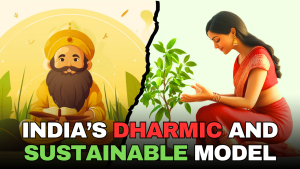Font size:
Print
Multistakeholder Approach to Urban Climate Action
Context:
India’s rapid urbanisation has brought significant economic progress, with urban areas generating nearly 80% of the country’s GDP.
More on News
- Currently, over 30% of India’s population resides in cities, a figure projected to reach 40% by 2030.
- However, this growth comes with challenges, as cities worldwide face existential threats from the escalating climate crisis.
- Extreme weather events have increased in frequency, causing immense loss of life and property.
Climate Change and Social Vulnerabilities
- Exacerbating Inequalities: The climate crisis exacerbates existing social inequities, with vulnerable groups—including low-income communities, informal settlers, women, and marginalised populations—bearing the brunt of its impacts.
- Access: Limited access to infrastructure and basic services compounds their vulnerabilities, threatening livelihoods and deepening inequalities.
- Comprehensive Approach: Addressing these interconnected challenges requires a comprehensive approach to building urban resilience, ensuring no one is left behind.
Governments’ Role in Building Resilience
- Sustainability and Equity: Governments and policymakers are critical in driving sustainability and equity in urban development.
- Integrating Resilience: By integrating climate resilience into urban planning, prioritising infrastructure in vulnerable areas, and adopting inclusive policies that address the needs of marginalised communities, governments can pave the way for long-term sustainability.
- Customised Solutions: Local governments, in particular, can customise solutions to align with the unique dynamics of their cities.
- Localised Interventions: Evidence suggests that city-level climate action plans can effectively guide localised interventions tailored to community needs.
The Power of a Multistakeholder Approach
- Civil Society: While governments play a central role, the importance of non-state actors—civil society organisations (CSOs), philanthropists, and local communities—cannot be overstated.
- India’s civil society, comprising over 3.1 million registered organisations, has been instrumental in advancing sustainability and equity across urban landscapes.
- Proximity to Communities: CSOs have a unique advantage due to their close proximity to communities, deep understanding of local contexts, and ability to advocate for equitable interventions.
- Historically, they have worked with vulnerable groups such as the urban poor, women, migrants, and people with disabilities, who are disproportionately affected by climate change.
- Effective Solutions: Several Indian organisations, such as Mahila Housing Trust, Waste Warriors, Saahas, and Biome Environmental Trust, have successfully implemented solutions for heat stress, water management, disaster resilience, and waste management.
- Bridge: Additionally, CSOs act as a bridge between policy and on-ground implementation, ensuring community needs are reflected in urban planning processes.
- Organisations like Janaagraha and Reap Benefit have further contributed by providing research, data, and advocacy to strengthen climate governance.
Strengthening Collaboration Through Philanthropy
- Funding: By offering long-term and flexible funding, philanthropic organisations can enable grassroots initiatives, facilitate sectoral research, and implement city-level pilot projects for resilience.
- Risk Appetite: Philanthropy also has a higher risk appetite, allowing it to complement the efforts of governments and multilateral agencies in driving climate action.
- The India Philanthropy Report 2023 revealed that over 90% of new-generation donors are prioritising climate change as a key cause.
- Insufficient Investments: Current funding for environment and sustainability initiatives stands at less than INR 200 crore (approximately $28 million), a small fraction of the overall philanthropic landscape.
- Most of this funding is concentrated in states like Maharashtra, Karnataka, and Andhra Pradesh, leaving vulnerable regions underserved.
The path to resilient and inclusive cities lies in collaboration. Governments, civil society, philanthropy, and communities must join forces, leveraging their unique strengths to create sustainable urban landscapes.



